
Aztec mythology is the body or collection of myths of the Aztec civilization of Central Mexico. The Aztecs were Nahuatl-speaking groups living in central Mexico and much of their mythology is similar to that of other Mesoamerican cultures. According to legend, the various groups who were to become the Aztecs arrived from the north into the Anahuac valley around Lake Texcoco. The location of this valley and lake of destination is clear – it is the heart of modern Mexico City – but little can be known with certainty about the origin of the Aztec. There are different accounts of their origin. In the myth the ancestors of the Mexica/Aztec came from a place in the north called Aztlan, the last of seven nahuatlacas to make the journey southward, hence their name "Azteca." Other accounts cite their origin in Chicomoztoc, "the place of the seven caves", or at Tamoanchan.

Mictlan is the underworld of Aztec mythology. Most people who die would travel to Mictlan, although other possibilities exist. Mictlan consists of nine distinct levels.
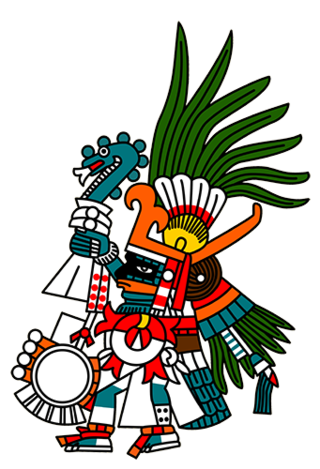
Huitzilopochtli is the solar and war deity of sacrifice in Aztec religion. He was also the patron god of the Aztecs and their capital city, Tenochtitlan. He wielded Xiuhcoatl, the fire serpent, as a weapon, thus also associating Huitzilopochtli with fire.
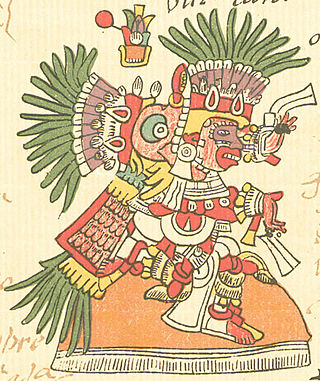
Tlahuizcalpantecuhtli[t͡ɬaːwisˈkaɬpantekʷt͡ɬi] is a principal member of the pantheon of gods within the Aztec religion, representing the Morning Star Venus. The name comes from the Nahuatl words tlāhuizcalpan[t͡ɬaːwisˈkaɬpan] "dawn" and tēcutli[ˈteːkʷt͡ɬi] "lord". Tlahuizcalpantecuhtli is one of the thirteen Lords of the Day, representing the 12th day of the Aztec trecena.

Mictlāntēcutli or Mictlantecuhtli, in Aztec mythology, is a god of the dead and the king of Mictlan (Chicunauhmictlan), the lowest and northernmost section of the underworld. He is one of the principal gods of the Aztecs and is the most prominent of several gods and goddesses of death and the underworld. The worship of Mictlantecuhtli sometimes involved ritual cannibalism, with human flesh being consumed in and around the temple. Other names given to Mictlantecuhtli include Ixpuztec, Nextepehua, and Tzontemoc.
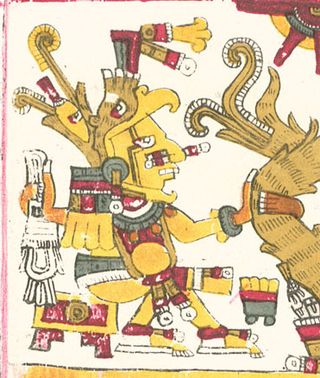
In Aztec mythology, Centeōtl[senˈteoːt͡ɬ] is the maize deity. Cintli[ˈsint͡ɬi] means "dried maize still on the cob" and teōtl[ˈteoːt͡ɬ] means "deity". According to the Florentine Codex, Centeotl is the son of the earth goddess, Tlazolteotl and solar deity Piltzintecuhtli, the planet Mercury. He was born on the day-sign 1 Xochitl. Another myth claims him as the son of the goddess Xochiquetzal. The majority of evidence gathered on Centeotl suggests that he is usually portrayed as a young man, with yellow body colouration. Some specialists believe that Centeotl used to be the maize goddess Chicomecōātl. Centeotl was considered one of the most important deities of the Aztec era. There are many common features that are shown in depictions of Centeotl. For example, there often seems to be maize in his headdress. Another striking trait is the black line passing down his eyebrow, through his cheek and finishing at the bottom of his jaw line. These face markings are similarly and frequently used in the late post-classic depictions of the 'foliated' Maya maize god.

In Aztec mythology, Tonacatecuhtli was a creator and fertility god, worshipped for peopling the earth and making it fruitful. Most Colonial-era manuscripts equate him with Ōmetēcuhtli. His consort was Tonacacihuatl.

In Aztec mythology, Patecatl is a god of healing and fertility and the discoverer of peyote as well as the "lord of the root of pulque". With Mayahuel, he was the father of the Centzon Totochtin.

In Aztec mythology, Tōnacācihuātl was a creator and goddess of fertility, worshiped for peopling the earth and making it fruitful. Most Colonial-era manuscripts equate her with Ōmecihuātl. Tōnacācihuātl was the consort of Tōnacātēcuhtli. She is also referred to as Ilhuicacihuātl or "Heavenly Lady."
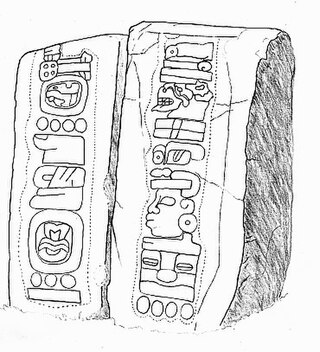
The calendrical systems devised and used by the pre-Columbian cultures of Mesoamerica, primarily a 260-day year, were used in religious observances and social rituals, such as divination.

The Aztec Empire or the Triple Alliance was an alliance of three Nahua city-states: Mexico-Tenochtitlan, Tetzcoco, and Tlacopan. These three city-states ruled that area in and around the Valley of Mexico from 1428 until the combined forces of the Spanish conquistadores and their native allies who ruled under Hernán Cortés defeated them in 1521.

The Aztec religion encompasses a complex range of practices and beliefs, being generally polytheistic while also embracing a certain tendency towards monistic pantheism. To some practitioners within the empire, the Nahua concept of teotl was represented most purely as the supreme dual god Ometeotl, while the empire's official religion also included a vast and diverse pantheon of gods with various attributes and tutelary associations. The popular religion tended to embrace the mythological and polytheistic aspects, even as the Aztec Empire's elite state religion sponsored both the monism of the upper classes and the popular heterodoxies.

In Mesoamerican mythology the Lords of the Night are a set of nine gods who each ruled over every ninth night forming a calendrical cycle. Each lord was associated with a particular fortune, bad or good, that was an omen for the night that they ruled over.

Quetzalcoatl is a deity in Aztec culture and literature. Among the Aztecs, he was related to wind, Venus, Sun, merchants, arts, crafts, knowledge, and learning. He was also the patron god of the Aztec priesthood. He was one of several important gods in the Aztec pantheon, along with the gods Tlaloc, Tezcatlipoca and Huitzilopochtli. Two other gods represented by the planet Venus are Tlaloc and Xolotl.
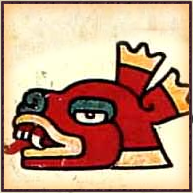
Dogs have occupied a powerful place in Mesoamerican folklore and myth since at least the Classic Period right through to modern times. A common belief across the Mesoamerican region is that a dog carries the newly deceased across a body of water in the afterlife. Dogs appear in underworld scenes painted on Maya pottery dating to the Classic Period and even earlier than this, in the Preclassic, the people of Chupícuaro buried dogs with the dead. In the great Classic Period metropolis of Teotihuacan, 14 human bodies were deposited in a cave, most of them children, together with the bodies of three dogs to guide them on their path to the underworld.
In Aztec mythology, Creator-gods are the only four Tezcatlipocas, the children of the creator couple Ometecuhtli and Omecihuatl "Lord and Lady of Duality", "Lord and Lady of the Near and the Close", "Father and Mother of the Gods", "Father and Mother of us all", who received the gift of the ability to create other living beings without childbearing. They reside atop a mythical thirteenth heaven Ilhuicatl-Omeyocan "the place of duality".
The Nahua people such as the Aztecs, Chichimecs and the Toltecs believed that the heavens were constructed and separated into 13 levels, usually called Topan or simply each one Ilhuicatl iohhui, Ilhuicatl iohtlatoquiliz. Each level had from one to many Lords (gods) living in and ruling them.














